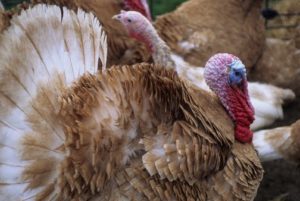 The end of year holidays are times when families gather around their tables, sharing meals and company, often organized around the cooking of a turkey, ham, or roast. During the three-month feasting period between Thanksgiving and the Super Bowl, we whip cream to dollop on pumpkin pies, sip egg nog, share breakfasts of eggs, bacon, sausage, cream cheese and lox. What many people may not realize, is that the many animals that we depend on for holiday meals and snacking, can be the victims of harsh suffering and tremendous environmental degradation. It doesn’t have to be this way.
The end of year holidays are times when families gather around their tables, sharing meals and company, often organized around the cooking of a turkey, ham, or roast. During the three-month feasting period between Thanksgiving and the Super Bowl, we whip cream to dollop on pumpkin pies, sip egg nog, share breakfasts of eggs, bacon, sausage, cream cheese and lox. What many people may not realize, is that the many animals that we depend on for holiday meals and snacking, can be the victims of harsh suffering and tremendous environmental degradation. It doesn’t have to be this way.
Consider the Thanksgiving turkey. The bird that the pilgrims sat down to enjoy on those original Thanksgiving gatherings was wild and native to the continent. Today’s conventional turkey is an industrial creature, the Broad Breasted White, bred to grow at a freakishly fast pace, raised on grain inside massive barns where their quality of life is severely compromised. In fact, male turkeys, or Toms, now grow so big so fast and are so breast heavy, most can barely stand up. Natural reproduction is out of the question. The industrial turkey is a totally manmade construction, dependent on artificial insemination. Often times to add flavor to these industrial birds, the meat is injected with vegetable oils, saline solutions, or animal proteins.
A similar factory-like scenario applies to most of the animal food products Americans buy around the holidays: cows, pigs, and chickens. An increasing majority of animals in the U.S. and other countries are raised in factory farms or CAFOs (concentrated animal feeding operations.) These enterprises are not the family farms of past times, with pigs rolling in the mud, cows grazing in pastures, and roosters crowing from fence posts. CAFOs are industrial-scale facilities where vast numbers of animals are confined, kept on life support with antibiotic medicines, and generate an output of sewage or waste comparable to a small metropolis.
The good news is that alternatives to this tragic animal factory scenario are out there and you don’t have to be a vegetarian to participate. (Though that certainly is an option.) Farmers around the country are increasingly turning toward better methods of livestock production. They are raising rare heritage breeds of turkeys on pastures where the birds grow more slowly and eat a more natural diet and are part of a local food economy. Many producers now raise animals without antibiotics and growth hormones, essential tools in industrial CAFO production. A number of organizations have standards for organic production and animal welfare. Many cooks are featuring a lot more grains and vegetables with perhaps smaller portions of higher quality, sustainably sourced meats, dairy, and eggs.
Knowing your farmer and understanding the conditions under which your food was grown is a profound way of giving thanks that also includes the raising of the animals that do so much to enrich our holiday celebrations. It could also lead to some of the most satisfying meals you’ve ever shared.
A few resources: